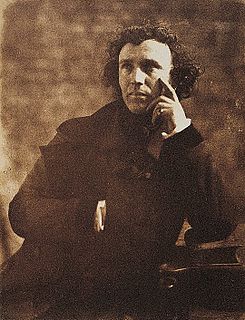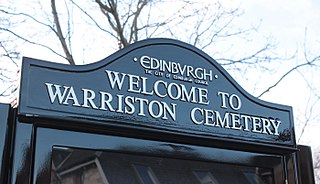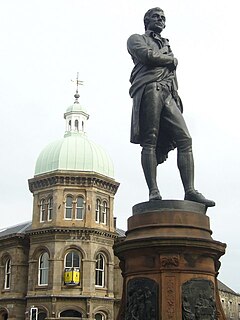
The Dean Cemetery is a historically important Victorian cemetery north of the Dean Village, west of Edinburgh city centre, in Scotland. It lies between Queensferry Road and the Water of Leith, bounded on its east side by Dean Path and on its west by the Dean Gallery. A 20th-century extension lies detached from the main cemetery to the north of Ravelston Terrace. The main cemetery is accessible through the main gate on its east side, through a "grace and favour" access door from the grounds of Dean Gallery and from Ravelston Terrace. The modern extension is only accessible at the junction of Dean Path and Queensferry Road.

The Royal Society of Edinburgh is Scotland's national academy of science and letters. It is a registered charity that operates on a wholly independent and nonpartisan basis and provides public benefit throughout Scotland. It was established in 1783. As of 2021, there are around 1,700 Fellows.

Sir John Robert Steell was a Scottish sculptor. He modelled many of the leading figures of Scottish history and culture, and is best known for a number of sculptures displayed in Edinburgh, including the statue of Sir Walter Scott at the base of the Scott Monument.

James Pittendrigh MacGillivray was a Scottish sculptor. He was also a keen artist, musician and poet. He was born in Inverurie, Aberdeenshire, the son of a sculptor, and studied under William Brodie and John Mossman. His works include public statues of Robert Burns in Irvine, Lord Byron in Aberdeen, the 3rd Marquess of Bute in Cardiff, John Knox in Edinburgh's St Giles Cathedral, and William Ewart Gladstone in Coates Crescent Gardens, Edinburgh.

John G. Mossman was one of a number of English sculptors who dominated the production and teaching of sculpture in Glasgow for 50 years after his arrival with his father and brothers from his native London in 1828. His father William Mossman (1793–1851) was also a sculptor, and a pupil of Sir Francis Chantrey. He was trained both by his father and under Carlo Marochetti in London.

William Brodie was a Scottish sculptor, working in Edinburgh in the 19th century.
William Birnie Rhind RSA (1853–1933) was a Scottish sculptor. Rhind was born in Edinburgh as the eldest son of sculptor John Rhind (1828–1892), and the elder brother of J. Massey Rhind. The two brothers set up a studio in Glasgow in 1885, then Birnie moved to Edinburgh, and his brother went to Paris, then permanently to America in 1889, despite the warnings of their father. His younger brother was Thomas Duncan Rhind, an architect.

Hippolyte Jean Blanc was a Scottish architect. Best known for his church buildings in the Gothic revival style, Blanc was also a keen antiquarian who oversaw meticulously researched restoration projects.

Sir George Washington Browne was a British architect. He was born in Glasgow, and trained there and in London. He practiced mainly in Edinburgh, where he designed a number of large public and commercial buildings, although his work is found throughout Scotland and Britain.

Warriston Cemetery is a cemetery in Edinburgh. It lies in Warriston, one of the northern suburbs of Edinburgh, Scotland. It was built by the then newly-formed Edinburgh Cemetery Company, and occupies around 14 acres (5.7 ha) of land on a slightly sloping site. It contains many tens of thousands of graves, including notable Victorian and Edwardian figures, the most eminent being the physician Sir James Young Simpson.

John RhindARSA (1828–1892) was a Scottish sculptor, based in Edinburgh. He was born in Banff the son of a master mason. He was trained under Alexander Handyside Ritchie (1804–1870). He served this apprenticeship in a yard at 4 East Broughton Place.
Charles d’Orville Pilkington Jackson ARSA, FRBS, FRSA was a British sculptor prominent in Scotland in the 20th Century. Throughout his career he worked closely with the architect Sir Robert Lorimer. He is most noteworthy for his creation of one of Scotland’s most iconic landmarks, the statue of Robert the Bruce at Bannockburn.

David Watson Stephenson was a Scottish sculptor, executing portraits and monuments in marble and bronze.

John Hutchison was a Scottish sculptor based in Edinburgh. He was the son of an unnamed builder, and his artistic life began as a thirteen-year-old woodcarving apprentice. He attended art school in the evenings, then later became a student at the Trustees Academy. and attracted the patronage of its owner, Patrick Allan Fraser, who gave him commissions to fund his study in Rome. Although after Rome he continued to enjoy ancient Roman sculptural themes, he remained in Edinburgh for the rest of his life, working in wood, clay and marble, and concentrating on portraiture of Scottish people, and images of Scottish myth and history. He created the bust of Sir Walter Scott in Poets' Corner in Westminster Abbey. He was a successful artist who received commissions from Queen Victoria.

John Stevenson Rhind was a Scottish sculptor based in Edinburgh.

Alexander Ignatius Roche RSA NEAC RP was a Scottish artist in the late 19th century and an important figure in the "Glasgow Boys".

Charles George Hood Kinnear FRIBA ARSA FRSE was one half of Peddie & Kinnear, one of Scotland’s most renowned and prodigious architectural firms, famed for their development of the Scots Baronial style, typified by Cockburn Street in Edinburgh which evokes a highly medieval atmosphere. Kinnear was also a pioneer photographer credited with inventing the bellows attachment on early cameras.

William Shirreffs was a Scottish sculptor in the 19th century.

George Clark Stanton RSA was a 19th-century Scottish sculptor, silversmith and portrait miniaturist.




















